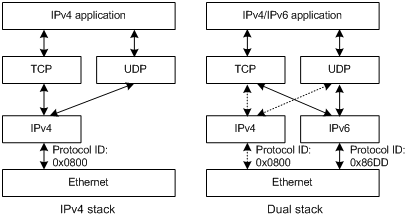| Title | Size | Downloads |
|---|---|---|
| 08-Dual Stack Configuration.pdf | 39.15 KB |
- Table of Contents
- Related Documents
-
| Title | Size | Download |
|---|---|---|
| 08-Dual Stack Configuration | 39.15 KB |
![]()
Layer 3 Ethernet interfaces mentioned in this section refer to Ethernet ports configured to operate in route mode. For how to switch the operating mode of an Ethernet port, refer to Ethernet Port Configuration in the Access Volume.
Dual Stack Overview
Dual stack is the most direct approach to making IPv6 nodes compatible with IPv4 nodes. The best way for an IPv6 node to be compatible with an IPv4 node is to maintain a complete IPv4 stack. A network node that supports both IPv4 and IPv6 is called a dual stack node. A dual stack node configured with an IPv4 address and an IPv6 address can have both IPv4 and IPv6 packets transmitted.
For an upper layer application supporting both IPv4 and IPv6, either TCP or UDP can be selected at the transport layer, while IPv6 stack is preferred at the network layer.
Figure 1-1 illustrates the IPv4/IPv6 dual stack in relation to the IPv4 stack.
Figure 1-1 IPv4/IPv6 dual stack in relation to IPv4 stack (on Ethernet)

Configuring Dual Stack
Enabling IPv4/IPv6 Dual-Stack Supporting
Follow these steps to enable IPv4/IPv6 dual-stack supporting:
|
Operation |
Command |
Remarks |
|
Enter system view |
system-view |
— |
|
Configure the protocol stack to be supported |
switch-mode { default | dual-ipv4-ipv6 | mce } |
Required By default, only IPv4 protocol stack is supported. |
|
display the information about the current system operating mode |
display switch-mode |
Available in any view |
![]()
l The configuration listed in Figure 1-1 takes effect only after the device is restarted.
l Before enabling dual-stack, you need to enable IPv4/IPv6 dual-stack supporting by using the switch-mode dual-ipv4-ipv6 command. Otherwise, IPv6 packets cannot be forwarded even if dual-stack is enabled.
Configuring Dual Stack
You must enable the IPv6 packet forwarding function before dual stack. Otherwise, the device cannot forward IPv6 packets even if IPv6 addresses are configured for interfaces.
Follow these steps to configure dual stack on a gateway:
|
To do… |
Use the command… |
Remarks |
||
|
system-view |
— |
|||
|
Enable the IPv6 packet forwarding function |
ipv6 |
Required Disabled by default. |
||
|
Enter interface view |
interface interface-type interface-number |
— |
||
|
Configure an IPv4 address for the interface |
ip address ip-address { mask | mask-length } [ sub ] |
Required By default, no IP address is configured. |
||
|
Configure an IPv6 address on the interface |
Configure an IPv6 global unicast address or site-local address |
Manually specify an IPv6 address |
ipv6 address { ipv6-address prefix-length | ipv6-address/prefix-length } |
Use either command. By default, no site-local address or global unicast address is configured on an interface. |
|
Configure an IPv6 address in the EUI-64 format |
ipv6 address ipv6-address/prefix-length eui-64 |
|||
|
Configure an IPv6 link-local address |
Automatically create an IPv6 link-local address |
ipv6 address auto link-local |
Optional By default, after you configured an IPv6 site-local address or global unicast address, a link local address is automatically created. |
|
|
Manually specify an IPv6 link-local address |
ipv6 address ipv6-address link-local |
|||
![]()
l For information about IPv4 addressing, refer to IP Addressing Configuration in the IP Services Volume.
l For more information about IPv6 address, refer to IPv6 Basics Configuration in the IP Services Volume.
l For how to enable IPv6 and configure an IPv6 address on an interface, refer to IPv6 Basics Commands in the IP Services Volume.

